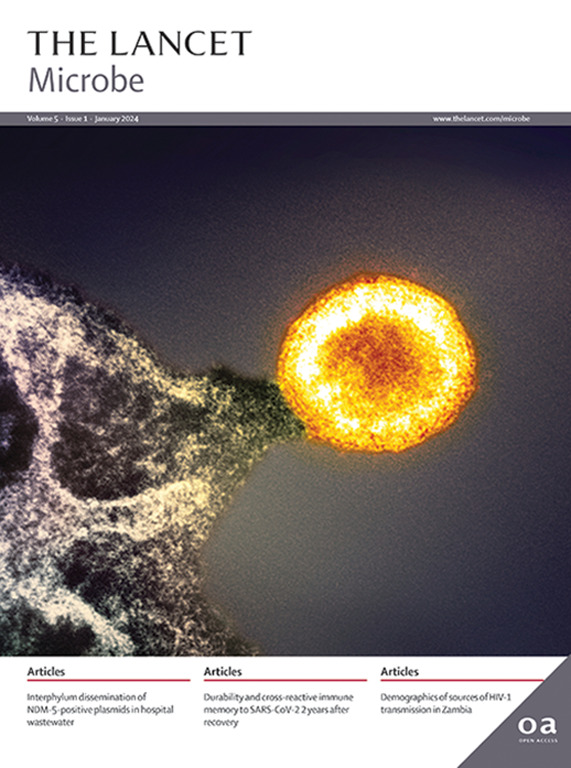Global emergence and transmission dynamics of carbapenemase-producing Citrobacter freundii sequence type 22 high-risk international clone: a retrospective, genomic, epidemiological study
IF 20.4
1区 生物学
Q1 INFECTIOUS DISEASES
引用次数: 0
Abstract
Background
Carbapenemase-producing Citrobacter (CPC) species have recently been recognised as emerging pathogens associated with nosocomial infections in humans. The increased rate of Citrobacter freundii infections is a public health concern and there is a paucity of genomic data regarding its global transmission dynamics. We aimed to characterise the genetic features of CPC species, and their associated carbapenemase-encoding plasmids, obtained from hospitalised patients in China and from publicly available global data, with a particular focus on high-risk clones.
Methods
This was a retrospective, genomic epidemiological study of CPC species obtained from a tertiary hospital in Zhejiang Province, China, from March 5, 2013, to March 5, 2023. We used antimicrobial susceptibility testing, short-read and long-read whole-genome sequencing, phylogenomic analysis, and plasmid structure analysis. A global dataset of complete plasmid sequences encoding blaKPC, blaNDM, and blaIMP was constructed from the National Center for Biotechnology Information (NCBI) RefSeq database to provide insights into their diversity and distribution. All carbapenemase-producing Citrobacter freundii genomes from the NCBI GenBank database were incorporated in the comparative genomic analyses. Bayesian phylogeographical analysis and growth rate assays were carried out to characterise the high-risk C freundii sequence type (ST) 22 clone.
Findings
1724 Citrobacter species isolates were collected from diverse clinical specimens, with 48 identified as CPC species. Citrobacter koseri (22 [46%] of 48) and C freundii (20 [42%]) were the predominant CPC species. Comparative analysis found C freundii carried significantly higher median numbers of plasmid replicons (5·0 [IQR 3·3–6·0] vs 2·0 [2·0–3·0]; p<0·0001) and acquired antimicrobial resistance genes (12·0 [7·3–15·8] vs 3·0 [3·0–5·3]; p<0·0001) than did C koseri. Molecular characterisation identified Inc-type plasmids, In823::Kl.pn.I3/In1589-like/In837-like integrons, Tn6296/Tn125/Tn5060 transposons, and insertion sequences (eg, IS26, IS3000, IS5, ISAba125, ISCR1), collectively facilitating the dissemination of carbapenemase genes. Global analysis of 3126 carbapenemase-encoding plasmids found epidemic plasmids with broad host ranges and global diversity. Phylogenetic investigation of predominant carbapenemase-encoding plasmids showed their persistence across geographical regions, temporal spans, and Enterobacterales species, exhibiting high genetic similarity to our clinical plasmids. A phylogenetic tree of 726 global carbapenemase-producing C freundii genomes showed that ST22 (227 [31·3%]) represents the predominant multidrug-resistant clone across community, health-care, and environmental niches. Transmission across continents contributes to the global predominance of the ST22 clone, which carries a high load of resistance genes (median 15·0 [IQR 11·0–17·0] vs 12·0 [3·0–16·0]; p<0·0001) and enhanced plasmid maintenance capacity (median replicons 5·0 [IQR 4·0–7·0] vs 4·0 [3·0–6·0]; p<0·0001) relative to non-ST22 clones.
Interpretation
Our study provides evidence to suggest that Citrobacter species are emerging carriers of carbapenem-resistance genes. These findings provide insight into the population structure of CPC species and highlight C freundii ST22 as a prominent high-risk international clone.
Funding
National Natural Science Foundation of China, National Health Commission Scientific Research Fund-Zhejiang Provincial Major Health Science and Technology Plan Project, Zhejiang Province Natural Science Foundation Project, Outstanding Youth Foundation of Jiangsu Province of China, the Priority Academic Program Development of Jiangsu Higher Education Institutions, and Postgraduate Research and Practice Innovation Program of Jiangsu Province.
产碳青霉烯酶的弗氏柠檬酸杆菌序列22型高风险国际克隆的全球出现和传播动态:回顾性、基因组学和流行病学研究
背景:产碳青霉烯酶柠檬酸杆菌(CPC)最近被认为是与人类医院感染相关的新兴病原体。弗氏柠檬酸杆菌感染率的上升是一个公共卫生问题,而且缺乏关于其全球传播动态的基因组数据。我们的目标是从中国住院患者和全球公开数据中获得CPC物种的遗传特征及其相关的碳青霉烯酶编码质粒,特别关注高风险克隆。方法:对2013年3月5日至2023年3月5日在浙江省某三级医院采集的CPC物种进行回顾性基因组流行病学研究。我们使用了抗菌药敏试验、短读和长读全基因组测序、系统基因组分析和质粒结构分析。从美国国家生物技术信息中心(NCBI) RefSeq数据库中构建了编码blaKPC、blaNDM和blaIMP的完整质粒序列的全球数据集,以深入了解它们的多样性和分布。来自NCBI GenBank数据库的所有产碳青霉烯酶的弗氏柠檬酸杆菌基因组被纳入比较基因组分析。采用贝叶斯系统地理分析和生长速率分析对高危弗氏疟原虫序列型(ST) 22克隆进行了鉴定。结果:从不同临床标本中分离到的Citrobacter菌株1724株,其中CPC菌株48株。48种病原菌中,克色柠檬酸杆菌(22种[46%])和弗氏杆菌(20种[42%])为优势菌种。对比分析发现,弗氏线虫携带的质粒复制子中位数明显高于前者(5·0 [IQR 3·3 ~ 6·0]vs . 2·0[2·0 ~ 3·0]);结论:我们的研究提供了证据,表明柠檬酸杆菌是碳青霉烯抗性基因的新兴载体。这些发现为CPC物种的种群结构提供了深入的见解,并突出了freundii ST22是一个突出的高风险国际克隆。资助项目:国家自然科学基金、国家卫健委科研基金、浙江省卫生科技重大计划项目、浙江省自然科学基金项目、江苏省杰出青年基金、江苏省高等学校重点学科建设项目、江苏省研究生科研与实践创新项目。
本文章由计算机程序翻译,如有差异,请以英文原文为准。
求助全文
约1分钟内获得全文
求助全文
来源期刊

Lancet Microbe
Multiple-
CiteScore
27.20
自引率
0.80%
发文量
278
审稿时长
6 weeks
期刊介绍:
The Lancet Microbe is a gold open access journal committed to publishing content relevant to clinical microbiologists worldwide, with a focus on studies that advance clinical understanding, challenge the status quo, and advocate change in health policy.
 求助内容:
求助内容: 应助结果提醒方式:
应助结果提醒方式:


